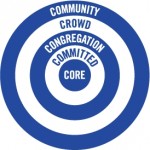If I Was Starting Today: Part 2
 (This is part 2 of a 7 part series. If you missed part 1, you can read it right here)
(This is part 2 of a 7 part series. If you missed part 1, you can read it right here)
If I knew then what I know now…I would have worked harder to be crystal clear on who my real customer was and designed my strategy to fit them. I realize that to some of us that seems so obvious…but let me unpack the idea before you hit delete.
Peter Drucker, famous for asking great questions, pushed organizations to ask themselves a few core questions. The first question was “What business are we in?” That was #1 in this series of posts. The second question he would push all of us to ask is, “Who is our customer?” But before we go any further, lets work on the word “customer.”
Classic Understanding of “Customer”
If we managed a restaurant or a grocery store we’d see this right away, but it might pay off to dig around the idea a little bit. If we thought about it we would quickly acknowledge that everyone who shops at our store or eats at our restaurant are our customers. We would be watching them carefully, trying to really understand their needs and interests, in order to keep them eating or shopping with us.
Clear so far? We would understand the word customer to mean the people already using our services or buying our products. At the same time we’d have hopes of expanding our customer base, attracting more customers, winning them over to shop or eat with us. We might understand the group going into the restaurant across the street as prospective customers…but we’d put most of our energy into catering to the group that already shops or eats with us. (Is this thinking starting to scare you?)
The Real Customer
When I use the term, “The real customer,” I’m talking about the people in the crowd who aren’t yet part of a small group. I believe understanding the crowd is the key to helping the unconnected people get connected. Paying attention to their challenges, interests, concerns and hopes will help you design a strategy that will inspire them to put a toe in the water.
What Is the Problem?
That seems so easy! Why aren’t we doing that already? Because we’re focusing on the challenges, interests, concerns and hopes of the people who are already deep on the inside…and that is a problem. Why? Because they’re different than the people in the crowd. Maybe only slightly, but they are different. If you want to help the people in the crowd move into community you will have to understand them and design your approach to appeal to them.
Why is that a problem? Thinking like the group just outside the congregation (the crowd) is a little bit of a stretch sometimes. The longer we’ve been in some kind of ministry, even the longer we’ve been a Christ-follower, the harder it gets to think like someone just outside and design our approach to appeal to them.
What Is the Solution?
Spend some of your energy getting to know the people in the crowd. You know some of them already. Some you only know by face…not by name. Getting to know them, reaching out to learn more about them, will help you see how to help them connect. I’ve found it helpful to simply ask myself if I could invite them to my small group? Would they like what we’re doing? Would it meet a need they are aware of? Would it help them with a challenge they know they have?
What Is the Bigger Problem?
Of course, this whole discussion leads to a different, bigger problem. How do I help my current customers begin to see themselves as team members who are empowered to help new customers connect? That is a discussion for a later post! In the meantime…take some time to get to know the people in the crowd. Think about them as you’re designing your connection strategy. They’re the real customer.
This is part 2 of a 7 part series. You can read part 3 right here.


But if you are asking these questions FIRST and you are asking who is my customer doesn’t it presume that you are asking it of the “community”? It is my understanding that Community comes before Crowd then to Committed. If you are asking it of those already using your services, your “crowd” it presumes you’ve already thought through “What is my business and who is my customer” becasue you have already attracted from the community and they have become crowd.
You can certainly argue for asking these questions of the “community” as opposed to the “crowd.” I see where you’re going. At the same time, what we’re talking about here is not as simple as figuring out how to get the community to “come to church.” It’s really much more about identifying the needs and interests of unconnected people (the crowd will frequently present the best opportunities) and then designing connecting opportunities that will encourage them to take the next step. You might take a look at Preoccupied with the Needs and Interests of the Right People for more info:
http://www.markhowelllive.com/preoccupied-with-the-needs-and-interests-of-the-right-people/
Love the discussion! What do you think?
mark